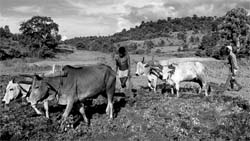Weighty task
 wide variations of nitrous oxide (n2o) emissions over varying areas and time periods make estimation a tough proposition. A study published in Current Science (Vol 79, No 10) says n2o emissions from soils used for different crops and in different seasons in India can have wide variations.
wide variations of nitrous oxide (n2o) emissions over varying areas and time periods make estimation a tough proposition. A study published in Current Science (Vol 79, No 10) says n2o emissions from soils used for different crops and in different seasons in India can have wide variations.
n2o is a greenhouse gas 30 and 200 times more potent than methane or carbon dioxide, respectively. Its emission not only depletes ozone but also reduces nitrogen content in the soil. In India, The Indian Agricultural Research Institute (iari) and the Central Rice Research Institute (crri) monitor n2o emissions from crop fields. Their research shows emissions from rice fields to be negligible. Only 0.01-0.1 per cent of applied nitrogen lost through n2o emissions, they observe.
The study says any estimate of n2o emissions from farms in India must consider the following factors, among others, that strongly affect emissions:
• Besides rice and wheat many other important crops such as sugarcane and pulses must be included for the study.
• Fertiliser and manure inputs in these crops should be taken into account.
• The estimate should consider the soil type, tillage practices, irrigation, type of fertilisers used, the method of applying fertilisers and soil temperature, besides other factors.
Indian farmers make extensive use of organic matter like compost, crop residue and cattle dung. The type of compost used as well as amount used varies greatly within the country. The quantity and type of organic compost used in India differs from that used in other countries. These differences can strongly influence n2o emissions.
The study points also out that even within a large-sized farming zone, difference in practices may result in different patterns of n2o emission. With so many variations, even among small farms, it is difficult to estimate n2o emissions from an area to near accuracy. Any correct estimation will need thorough details of all farming units, small or large
